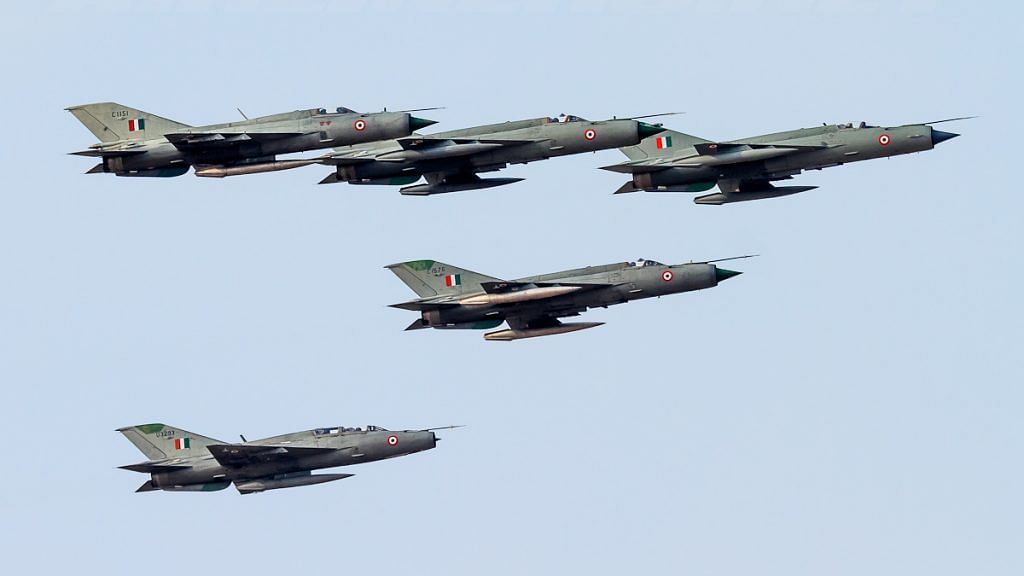New Delhi: Defence Minister Rajnath Singh formally received India’s first Rafale fighter jet in France’s Merignac Tuesday, but the Indian Air Force still has a long way to go in terms of gradually replacing its ageing fleet and substituting them with modern fighter jets.
A major chunk of the IAF inventory consists of jets and helicopters which are barely used anymore by its counterparts from around the world.
ThePrint lists some of the rare birds that the IAF continues to fly, albeit in upgraded form.
Also read: Army plans to buy 350 helicopters over 10 years to modernise its Aviation Corps
MiG-21 and variants
The Soviet-origin MiG-21 Bison is one of India’s six fighter jets. It is a single-engine, single-seater multi-role fighter/ground attack aircraft, which forms the “back-bone of the IAF”, according to its website.
First inducted into the IAF in 1963, the supersonic MiG-21 was initially developed as an interceptor, but was later upgraded to perform other functions of a combat aircraft, including ground attacks. There were various reasons for this, but primary among them was a paucity of funds.
MiG-21s have been produced in nearly a dozen variants, of which the IAF has had several, including Type-77, Type-96 and the ‘bis’.
The Bison is the latest upgrade, and over 100 MiG-21s have received the upgrade since 2006.
Currently, the IAF has four operational squadrons of MiG-21 Bisons and one mixed squadron. The mixed squadron is slated to be phased out by the end of 2019, while the rest are to be phased out over the next five to six years.
Around the world, the MiG-21 is hardly in use anymore. According to some reports, the MiG-21 currently serves in 18 air forces worldwide, including two members of NATO (Romania and Croatia).
In fact, Russia, which phased out the MiG-21 in 1985, even before the collapse of the Soviet Union, recently asked India for three aircraft to be used to demonstrate vintage flying. India agreed to the gift.
Also read: This is the MiG-21 Bison, the fighter jet Wg Cdr Abhinandan flew to take on Pakistan’s F-16s
Jaguar
The Jaguar is a twin-engine, single-seater deep penetration strike aircraft of Anglo-French origin, with a maximum speed of 1,350 km/h. The first ones were inducted by the IAF on 26 July 1979 in the 14 Squadron ‘The Fighting Bulls’ at Ambala air base. It has been instrumental in various IAF missions, including photo reconnaissance.
Currently, the IAF operates six squadrons of the Jaguar. However, in reality, there are only five squadrons, as the sixth is not a complete squadron.
The IAF plans to gradually phase out the Jaguars, and has stopped its engine upgrade, owing to the high cost quoted by Honeywell and HAL.
The French reportedly retired their Jaguars in 2005 and replaced them with the Rafale. The UK, Ecuador, Nigeria and Oman have also discontinued them.
Also read: IAF set to shelve Jaguar engine upgrade, could buy more Su-30 MKIs instead
MiG-27
Expected to be phased out completely from the IAF by the end of 2019, the MiG-27 is a Russian-origin ground-attack aircraft which was manufactured by HAL under a licence agreement. Bought from the Soviet Union in the 1970s, it is one of the rare birds that both India and Kazakhstan operate.
Sri Lanka also had MiG-27 fighters acquired in the early 2000s, which are no longer operational.
Also read: 10 crashes, 11 aircraft lost, 22 killed — the year of Balakot has been a bloody one for IAF
Avro
The Avro Hawker Siddeley HS748 is a twin-engine turboprop military transport and freighter of British origin. The aircraft, which could carry 48 paratroopers or six tonnes of freight, has been in the IAF fleet since the 1960s, but hasn’t been used to its optimal capacity.
The fleet of 56 aircraft is likely to be replaced by Airbus’ C-295. The aircraft was shortlisted years ago, but the negotiations have been stuck. In the meantime, HAL is also offering an upgraded Avro with new engines and avionics, which would reportedly extend the life of the aircraft by two decades.
Also read: Indian Army tanks now have sharper night vision equipment developed by DRDO
Chetak/Cheetah choppers
The Vintage Chetaks and Cheetah helicopters used by all four services — the Army, Navy, Air Force and the Coast Guard — are just flown in a handful of countries.
The IAF is still looking for 197 Light Utility Helicopters to replace the Chetak and Cheetah fleet, which is of 1960s and 1970s vintage.
The Chetak is a single-engine, light utility helicopter manufactured in India under licence from French firm Aerospatiale (originally SNIAS) by HAL, beginning in 1962. The difference between the two is that the Chetak has wheels while the Cheetah has skis as its landing gear. The Cheetah also has fewer seating capacity.
Both the types are used for commuting, observation, surveillance, logistics support and rescue operations.
HAL has so far produced more than 350 Chetaks and delivered around 80 to the Navy, of which 51 helicopters are still flying. It has also produced over 275 Cheetahs, according to its website.
HAL has also collaborated with France’s Turbomeca to make a more powerful ‘Shakti’ engine for the Cheetah, in a variant called the Cheetal, for use in high altitudes.
The Navy is now looking to purchase 111 helicopters through the strategic partnership route to replace its ageing Chetaks.
Also read: Private players cry foul as HAL submits 2 bids for mega Navy chopper deal
